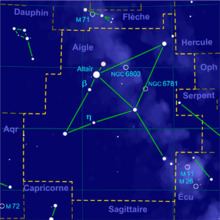Luminosity 68 ± 14 L☉ | Magnitude 3.26 Apparent magnitude (V) 3.26 | |
 | ||
Similar Delta Aquilae, Lambda Aquilae, Eta Aquilae | ||
Theta Aquilae (θ Aql, θ Aquilae) is a binary star in the constellation Aquila. The combined apparent visual magnitude of the pair is 3.26, making it the fourth-brightest member of the constellation. In Chinese, it has the traditional name Tseen Foo, which is derived from the Mandarin 天桴 tiānfú meaning "the heavenly raft(er)"; it may also mean drumsticks, with Altair, Beta Aquilae and Gamma Aquilae being the drum. This distance to this star can be determined through the parallax technique, yielding an estimate of roughly 286 light-years (88 parsecs) from Earth.
Contents
Properties
Theta Aquilae is a double-lined spectroscopic binary, which indicates that the individual components have not been viewed through a telescope; instead, what can be viewed is their combined spectrum with the individual absorption line features shifting back and forth over the course of an orbit because of the Doppler effect. Their orbit has a period of 17.1 days with a large orbital eccentricity is 0.60. At the estimated distance of this system, the angular separation of 3.2 milliarcseconds corresponds to a physical separation of only about 0.24–0.28 astronomical units.
Both stars have a matching stellar classification of B9.5 III, indicating that they are massive, B-type giant stars that have exhausted the supply of hydrogen at their cores and evolved away from the main sequence of stars like the Sun. Hummel et al. (1996) gave the primary component, θ Aql A, an estimated mass of 3.6 solar, a radius 4.8 the Sun's, and 278 the luminosity of the Sun. For the secondary component, θ Aql B, they give the corresponding parameters as 2.9 times the mass, 2.4 times the radius and 68 times the luminosity of the Sun. Based upon their estimated parameters, Kaler (2008) suggests that θ Aql A is actually a subgiant star, while θ Aql B is a main sequence star.
Etymology
In Chinese, 天桴 (Tiān Fú), meaning Celestial Drumstick, refers to an asterism consisting of θ Aquilae, 62 Aquilae, 58 Aquilae and η Aquilae. Consequently, θ Aquilae itself is known as 天桴一 (Tiān Fú yī, English: the First Star of Celestial Drumstick.)
In the catalogue of stars in the Calendarium of Al Achsasi al Mouakket, this star was designated Thanih Ras al Akab (تاني ألرأس ألعقاب - taanii al ra’s alʕuqāb), which was translated into Latin as Secunda Capitis Vulturis, meaning the second (star) of eagle's head.
This star, along with δ Aql (Denebokab) and η Aql, were Al Mizān (ألميزان), the Scale-beam. According to the catalogue of stars in the Technical Memorandum 33-507 - A Reduced Star Catalog Containing 537 Named Stars, Al Mizān were the title for three stars :δ Aql as Al Mizān I, η Aql as l Mizān II and θ Aql as Al Mizān III.
